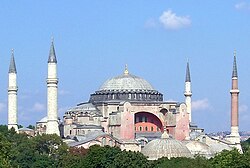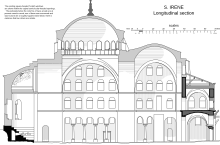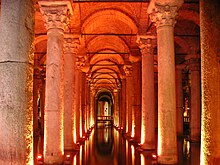Byzantine architecture

The Byzantine architecture includes the architecture , which during the Byzantine Empire and in the Byzantine art influenced countries Bulgaria , Serbia , Russia , Armenia and Georgia has emerged. The Byzantine Empire developed from the eastern half of the Roman Empire and is named after Byzantium, which had been the capital of Eastern Rome since 330 (as Constantinople ) and where the most important evidence of Byzantine architecture can be found. This architectural epoch can be roughly divided into three phases: the early, the middle and the late (Komnenische and Palaiological) epoch.
Significant structures
Early Byzantine architecture is essentially a continuation of Roman architecture . From this, a style gradually developed that took up influences from the Middle East and for which the Greek cross was decisive for the design of the floor plan in church architecture . Brick instead of natural stone was increasingly used for the building materials, the classical column arrangements were designed more freely, a central element became mosaics , which increasingly replaced chiseled representations. In addition, increasingly complex domes were built.
Early era


The most significant examples of early Byzantine architecture date back to the reign of Emperor Justinian and can be found in Ravenna and Constantinople. The fact that Justinian's architects succeeded in developing a complex system that enables an elegant transition from the linear floor plan of a (church) building to its dome (s) represents a decisive step forward in architectural history.
In Ravenna, the central building of San Vitale and the elongated basilica of Sant'Apollinare Nuovo should be mentioned. In Constantinople, under Justinian, the well-known Hagia Sophia and Hagia Irene were created , next to them the somewhat earlier Saint Sergius and Bacchus (also called Little Hagia Sophia ), which may have served as models for the other two churches, because as with these, there is also here a combination of elements that are characteristic of the elongated basilica style as well as those used in central buildings.
One of the most important non-ecclesiastical buildings of this time is the Great Palace of Constantinople , which is now in ruins, and the Theodosian Land Wall (which was, however, already begun under Theodosius II) , which with its length of 20 km and its mighty towers is an important sight of the city to this day and which was a decisive factor in the fact that the Byzantine Empire was able to survive the fall of Western Rome for a whole millennium. Mention should also be made of the “ Sunken Palace ”, a huge underground cistern system built in the 530s. An idea of what a Byzantine palace looked like at that time is given by a frieze that has been preserved in the Eastern Gothic royal palace of Ravenna. The monumental Sangarius Bridge (6th century) and the Karamagara Bridge (5th / 6th century), one of the earliest pointed arch bridges, stand out in the bridge construction .
In the “province” the following are to be mentioned above all: Hagios Demetrios in Thessaloniki , the St. Catherine's Monastery on Sinai and Djvari in today's Georgia . This also includes the three important churches in Etchmiadzin in today's Armenia , buildings that were mostly built in the 7th century and which are characteristic of the development of church construction in the Byzantine Empire in the period following Justinian.
Middle epoch
In the middle epoch of Byzantine history, there were few notable innovations in architecture. The iconoclasm dominating at this time was not conducive to extensive decoration of church buildings. In terms of new buildings, the Hagia Sophia in Thessaloniki and the Church of the Assumption of Mary in Nikaia should be mentioned in particular ; the latter was destroyed in the 1920s.
The time of the Macedonian dynasty ( 867 - 1056 ) is considered to be the epitome of Byzantine art, but did not leave very many significant traces in architecture. The. In the 9th century under I. Basil built Votive Church of Theotokos of Phoros (which no longer exists) was probably the model for most of the next religious buildings, including the monastery church Hosias Lukas in Greece (1000), the katholikon of Nea Moni on Chios (under Constantine IX ) and the Daphni monastery near Athens, which was built around 1050 .
The building method of that time was also adopted in the settlement areas of the Slavs, who were converted by Greek Orthodox missionaries. Among the most important buildings here is the Hagia Sophia von Ohrid and above all the Kiev Cathedral of St. Sophia , which plays an important role in the further architectural history of Russia. Both buildings reflect the tendency towards more and more secondary domes, which have now been placed on top of cylindrical structures.
Comnenian and Palaeological epoch

In Constantinople and Byzantine Asia Minor there are only a few architectural testimonies from the Komnenian period, apart from a few rock-cut churches in Cappadocia such as Elmali Kilise. Instead, buildings on the periphery of the Byzantine world have been preserved, where the Byzantine circle of forms developed into characteristic national styles, especially in the Transcaucasian countries, in Russia , Bulgaria , Serbia and other Slavic countries, as well as in Sicily (here above especially the Cappella Palatina ) and in Veneto ( St. Mark's Basilica , Torcello Cathedral), which, despite the church split in the 11th century, remained Byzantine influenced for a long time.
The Fourth Crusade of 1203 / 1204 brought not only a significant weakening of the Byzantine Empire with it, which was brought by the attack of the crusaders to the brink of extinction, the conquest of the capital also went with the looting and destruction of numerous and architectural treasures along. Only with the reconquest of the city by the palaeologists did a certain cultural upswing set in again, which was also reflected in the construction of new churches. In Constantinople alone, a dozen new sacred buildings were built, including the Chora Church and the Church of Maria Pammakaristos. In contrast to the Slavic churches, the palaeological architects did without the special emphasis on the vertical, so that the corresponding buildings often appear rather inconspicuous (with the exception of Hagia Sophia in Trebizond ).
The most important patrons of Byzantine architecture after the fall of Constantinople were the members of the Serbian Nemanjid ruling dynasty on the Balkan peninsula . With the establishment of the Church of Our Lady in Studenica Monastery as the later church of the grave of the dynastic founder Stefan Nemanja , all other Serbian kings and emperors built their foundations on Byzantine models. This patronage reached its climax in the time of Stefan Uroš II Milutin . The main work of the paleological five-domed churches was the Gračanica Monastery, which is based on a balanced synthesis of a Byzantine cross-domed church with vertical accentuation and dynamism. At the same time, the Katholikon was created in Hilandar Monastery on direct Comnenian models in Constantinople. The largest late medieval religious building on the Balkan Peninsula, the Katholikon in the Visoki Dečani monastery, has a special position, as it shows Gothic style elements and a basic floor plan. A related synthesis can be found a century later in the Manasija monastery , whereby this belongs to the church type that was established at the end of the 14th century and always has a triconchonal floor plan. In the late phase of Byzantine architecture, the churches generally had a polychromatic facade design and striking ornamentation. They matured to their stylistic perfection in the Kalenić monastery .
The Church of the Apostles in Thessaloniki is a characteristic building for the late Byzantine period, the outer wall of which has a detailed decoration in complex brick construction or with shiny ceramics. Other buildings erected in the period before the final fall of Constantinople include the monasteries on Mount Athos and in Mystras (such as the Brontocheion monastery).
Structural features
The churches built under Constantine in Palestine already have two basic building plans: the basilica , an axial structure, as found in the Church of the Holy Sepulcher in Jerusalem, and the central structure , which is found in the octagonal church buildings in Antioch . Central buildings were almost always vaulted , so they usually had a central dome . This required the construction of relatively massive walls, which had to absorb the weight of the dome, but which were often provided with deep niches, as in the Georgskirche of Salonika from the 5th century. In addition, one encounters vaulted aisles as in the church of Santa Costanza in Rome (4th century) or the central building was expanded on four sides by additions, so that the floor plan was in the shape of a cross, as with the mausoleum of Galla Placidia in Ravenna from the 5th century. The most famous church with such a cross-shaped floor plan was the Apostle Church in Constantinople. Vaults were also used very early on in basilicas, for example in the 6th century Hagia Irene in Constantinople, where the elongated structure is covered with two domes.

At the Sergius Church in Constantinople and at San Vitale in Ravenna, two churches belonging to the central building type, one can find an expansion of the octagonal interior through additions to the apse , which resulted in a combination that was among the most important achievements in Byzantine architectural history counts. The original length of 30 meters could be extended to 60 meters by adding two semicircles on the west and east side, with three smaller apses in the east and two in the west being added to these semicircles, so that a structure of 80 meters in length, which reached a width of 30 meters in the central area and which was completely covered with domes: Two half-domes, which cover the semicircles, rise above the snail-like small apses, and the mighty central dome rises between these half-domes. This is supported in the south and north by the vaults of the two-story central aisle, which gives the building a rectangular floor plan.
The cross-shaped plan of the Apostle Church from the 6th century was provided with five domes, the middle one being the highest. After the 6th century, there were no more churches that could in any way compete with those built under Justinian; instead, the buildings came closer and closer to the standard that had now been achieved. The central area with the central dome was integrated into a significantly larger rectangle, the four sections of which, corresponding to the cardinal points, were made higher in the vault system of the church than the areas of the corners, so that aisles and transepts were created in this way. The central area was sometimes rectangular, sometimes octagonal, or at least eight instead of four pillars supporting the dome were built, while the aisles and transepts were narrower.
A typical construction plan of the time can be achieved by dividing the sides of a square into three sections, with the middle sections each being longer than the side, and then connecting the opposite sides accordingly, so that nine smaller squares result. Now three apses are added on the east side, while an entrance portal is added to the west, which extends to the front. There on the front there is a rectangular courtyard that serves as an atrium and usually contains a fountain. The entrance portal is the so-called narthex of the building, under the dome is the pulpit , from where the scriptures are read, while under the pulpit is the room for the choir of the singers. In the east of the central room there was a partition that separated the so-called bema , the area where the altar was located, from the rest of the room. This partition, which was decorated with pictures, formed the iconostasis . The altar itself was protected by a canopy ( ciborium ) supported by columns. In the curve of the apse was an ascending row of benches, the synthronon, in the middle of which, at the easternmost point, was the patriarch's throne . The two smaller areas and apses on the sides of the bema served as sacristies and were called diakonicon and prothesis . The pulpit and the bema were connected by the so-called solea, an elevated corridor surrounded by a railing or a low wall.
The influence from the east was particularly evident in the way the outer brick walls were decorated. The walls of the 12th century for example, the bricks of which were shaped rather roughly, were placed in such a way that horizontal ornamental lines resulted, which were based on patterns of the Kufic script. There are also other patterns, zigzag lines, and the like, as they were used to decorate many Persian buildings. The domes and vaults were covered on the outside with lead or with roof tiles, as they were already used in the Roman Empire. The window and door frames were made of marble , while surfaces inside the buildings, especially in the higher parts, were richly decorated with mosaics and frescoes and the walls in the lower areas were covered with marble slabs, which formed a continuous surface , through the selection of particularly beautiful specimens but formed a colorful row of large panels.
The Byzantine Heritage
In the west, the Byzantine architectural style was z. B. represented in Sardinia , replaced by the Romanesque and finally the Gothic architecture. In the east he exerted a decisive influence on Islamic architecture. The Byzantine influence can be clearly seen in such important buildings as the Umayyad Mosque in Damascus or the Dome of the Rock in Jerusalem, which Byzantine craftsmen and decorators were involved in building. Byzantine architecture was practiced in locally influenced forms in Russia, Romania, Georgia and other Orthodox countries until after the fall of the Byzantine Empire, where it developed into national forms.
Byzantine elements have been revived in modern times by the Neo-Byzantine architecture , which was cultivated in the 19th century. In Russia, Konstantin Thon was one of its most important representatives, who had numerous students and who created the Volodimir Cathedral in Kiev, the Nicholas Cathedral in Kronstadt, the Alexander Nevsky Cathedral in Sofia and the New Athos Monastery near Sukhumi. One of the largest neo-Byzantine buildings of the 20th century. counts the Cathedral of St. Sava in Belgrade.
literature
- Helen C. Evans, ed., Byzantium: Faith and Power (1261-1557), exh. cat. New York: Metropolitan Museum of Art; New Haven: Yale University Press, 2004. 658 pp., 721 color ills., 146 b / w.
- architecture
- Slobodan Ćurčić : Religious Settings of the Late Byzantine Sphere . In: Byzantium: Faith and Power (1261–1557), edited by Helen Evans (The Metropolitan Museum of Art, New York, 2004).
- Cyril Mango : Byzantine Architecture . Stuttgart 1975, ISBN 3-7630-1703-8
- Richard Krautheimer : Early Christian and Byzantine architecture . 4th ed., Harmondsworth 1986, ISBN 0-14-056168-4 , ISBN 0-300-05294-4
- Nadežda Katanić: Decorative camea plastika Moravske škole . Prosveta, Republički zavod za zaštitu spomenika kulture, Beograd, 1988. ISBN 86-07-00205-8
See also
- Byzantine Empire
- Byzantine art
- Byzantine iconoclasm
- List of Byzantine museums
- List of Byzantine churches in Sardinia
- List of Byzantine Orthodox Monasteries
- List of Byzantine Spolia in Venice


